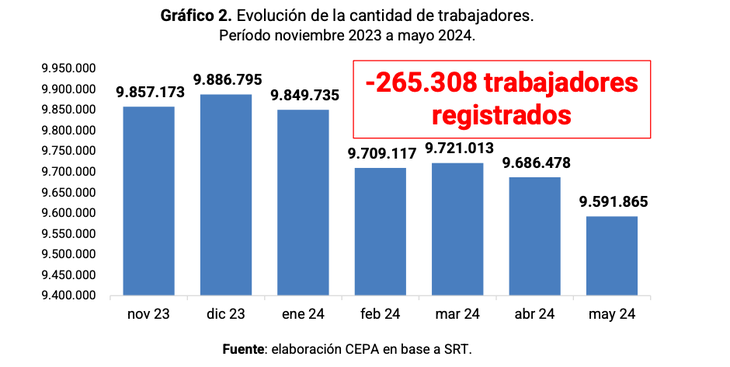The data comes from the latest report from the Center for Political Economy of Argentina (CEPA). It highlights that, however, and despite the fact that most of the closures came from SMEs, the document found that 70% of registered workers who lost their jobs during that period came from large companies.
This phenomenon had already been warned by business chambers, which pointed out that SMEs avoid staff reductions because “It involves a disinvestment that is very difficult to reverse if the situation improves.“.
According to information published by the Superintendency of Labor Risks (SRT) related to Social Security, CEPA calculated that the number of employers was reduced by 9,972 cases between November 2023 and May 2024. The document details that the main affected in these first six months of Javier Milei’s management were companies with up to 500 workers, which represented 99.5% of the total cases (9,927 fewer companies). In contrast, companies with more than 500 employees accounted for only 0.5% of the reduction in employers, with 45 cases.
Breaking down the data
Analysis of these data revealed that the layoffs were concentrated in larger companies. Seventy percent of the reported job losses occurred in companies with more than 500 employees. By comparison, during the same period, companies with fewer than 500 employees contributed to 30 percent of job losses, reducing their workforce by 78,951 positions.
In total, a loss of 265,308 jobs, a figure significantly higher than that estimated by the Argentine Integrated Pension System (SIPA), which reported a decrease of just over 175,700 jobs, including registered wage earners and domestic workers.
Employment strain.png
Reducing staff not only means a loss of investment that is difficult to recover.
From the perspective of SMEs, it was explained that staff reduction limits their ability to react to a possible increase in demand. In addition, laying off employees is very costly for these companies, since many of them have received training financed by the SMEs themselves.
Reducing staff not only implies a loss of investment that is difficult to recover, but also reduces the availability of strategies to deal with the current situation. Fewer staff means fewer “thinking heads” and fewer resources to diversify production, which limits the ability of SMEs to cover new types of demand.
CEPA.png

Fewer staff means fewer “thinking heads” and fewer resources to diversify production.
Thus, the document concludes that when analyzing the decline in registered employment by company size, it can be seen that during the first months of Milei’s administration, the expulsion of workers was concentrated in larger companies: 70% of the loss of employment (-186,357 registered workers) was concentrated in companies with more than 500 workers.
In contrast, in the six months between November 2023 and May 2024, staff reductions by companies with fewer than 500 employees were significantly lower: Their jobs were reduced in 78,951 cases, accounting for 30% of the total.
In percentage terms, while companies with more than 500 employees reduced their staff by 3.90% (from 4,782,973 to 4,596,616), companies with up to 500 employees reduced their staff by 1.56% (from 5,074,200 to 4,995,249).
Source: Ambito




